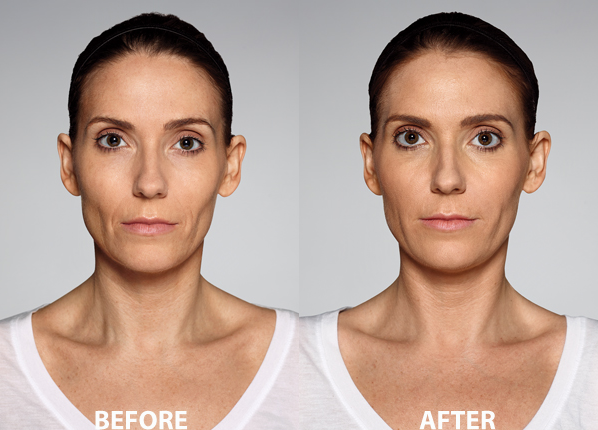DERMAL FILLER

What Are Dermal Fillers?
As we age, the body slows its production of collagen, and the face sags, wrinkles, and loses volume. These signs of aging can cause a number of negative effects, like low self-esteem and lack of confidence. Luckily, there are a few ways to reverse aging symptoms. Surgery, for example, is an excellent, long-term solution that manipulates and rearranges facial architecture.
However, not all patients wish to undergo an invasive surgical procedure. In these cases, Dr. Steven recommends dermal fillers. Dermal fillers are injectable chemical solutions that add volume to the face, plump lips and cheeks, and smooth wrinkles and lines. They can also make features more symmetrical.
Most dermal fillers are made of a substance called hyaluronic acid (HA). Hyaluronic acid is a naturally occurring substance found in the body that acts as a lubricating agent in the joints and tissues. When injected, hyaluronic acid fillers are effective at smoothing and adding volume to the face.
How Long Will Dermal Fillers Last?
While dermal fillers are very effective, they are temporary solutions. On average, they last between 6 and 12 months. Some brands may last longer, for up to 2 or more years. Over time, the body reabsorbs and safely metabolizes dermal fillers, and the face returns to its original shape and appearance.
Dermal fillers may last longer in some patients. This is due to several factors, including genetics, diet, and overall health. Certain areas of the face also hold filler longer than others.
What Areas of the Face Can Fillers Treat?
Facial fillers are versatile injectable treatments that target a number of facial areas. These include, but are not limited to:
- Lips
- Cheeks
- Forehead
- Chin
- Nose
- Marionette lines
- Nasolabial folds
When multiple areas of the face are being treated with dermal fillers, it is sometimes called a liquid facelift.

Dermal fillers are designed to be versatile. Many dermal filler brands have a few different subset types that offer specific improvements. The Juvéderm brand, for example, includes Juvéderm XC, Juvéderm Ultra XC, and Juvéderm Ultra Plus XC. All of these focus on different areas of the head and neck.
What Types of Dermal Fillers Does Dr. Steven Use?
Dr. Steven uses a variety of dermal fillers to accomplish his facial rejuvenation goals, though he most commonly uses Juvéderm, Restylane, and Radiesse.
Juvéderm and Restylane are hyaluronic acid fillers that target wrinkles, folds, and areas where volume has been lost. Juvéderm works best on the forehead, the brows, and the areas around the mouth, though it can also fill the lips and nose. Restylane also corrects wrinkles and folds, including those on the forehead, between the brows, and around the mouth. It can also fill the cheeks.
Radiesse, on the other hand, is made from a compound called calcium hydroxyapatite (CaHA). CaHA is comprised of phosphate and calcium ions, both of which naturally occur in the human body. Radiesse fills wrinkles, adds volume to the face, and can even be used for non-surgical rhinoplasty procedures. It also stimulates the body’s production of collagen as it is gradually absorbed.
Injections can be completed in 15 to 60 minutes, and there is no downtime after treatment, meaning patients can immediately return to their normal activities.
What Happens When Fillers Wear Off?
When dermal fillers wear off, the areas that have been treated should return to their normal shape. In other words, the affected skin and tissues will not be negatively affected by the injections.
After results have faded, patients are welcome to return to Stellar Clinic for repeat maintenance treatments. This will keep the face looking as young, smooth, and tight as possible.
Facial Fillers for Wrinkles

The most consistently effective dermal fillers for wrinkles and folds are hyaluronic acid fillers. Popular, trusted brands include Juvéderm, Restylane, Belotero, Revanesse, and Revance. All of these have the ability to tighten sagging skin and fill mild to moderate wrinkling and sagging.
There are a few other dermal filler types, including calcium hydroxyapatite (Radiesse) and poly-l-lactic acid (Sculptra). These are effective at treating wrinkles and loose skin. They also restore lost volume.
Are Dermal Fillers Safe?
Dermal fillers are proven to be safe and infrequently cause severe complications. If a patient is unhappy with the outcome of a hyaluronic acid filler, Dr. Steven can inject an enzyme, called hyaluronidase, to dissolve the material within 24 hours.
The most common side effects of dermal filler injections include bruising, swelling, and redness around the injection site. More serious complications, like bleeding and facial asymmetry, are rare.
What Is the Difference Between Dermal Fillers and Botox?
Dermal fillers and BOTOX work very differently. Facial fillers, on the one hand, are generally made from hyaluronic acid or other chemical compounds that add volume to the face. They can also fill wrinkles and smooth lines and sagging skin.
BOTOX, on the other hand, is made of botulinum toxin, which blocks nerve signals to specific facial muscles. This paralyzes the muscle tissue and smooths the skin that lies above.
Dermal fillers tend to last longer than BOTOX. The average facial fillers last between 6 and 12 months, whereas BOTOX only lasts for about 3 months. Both options require repeat treatments if patients wish to maintain results.
